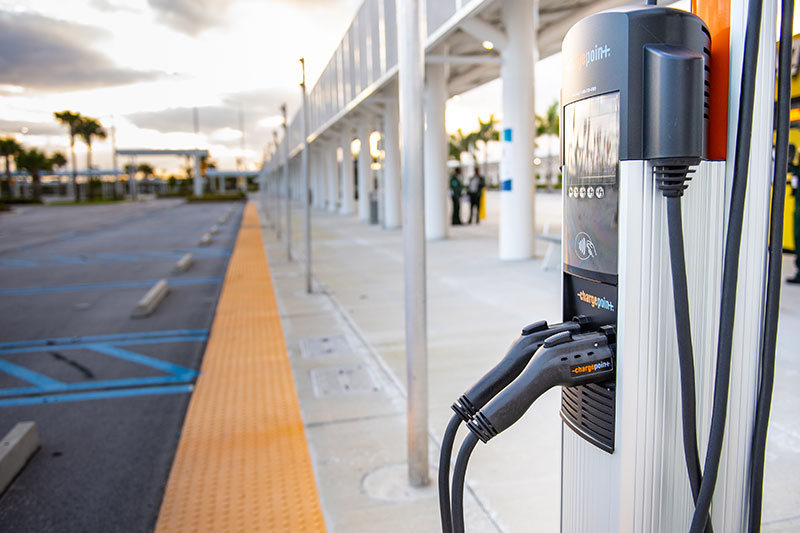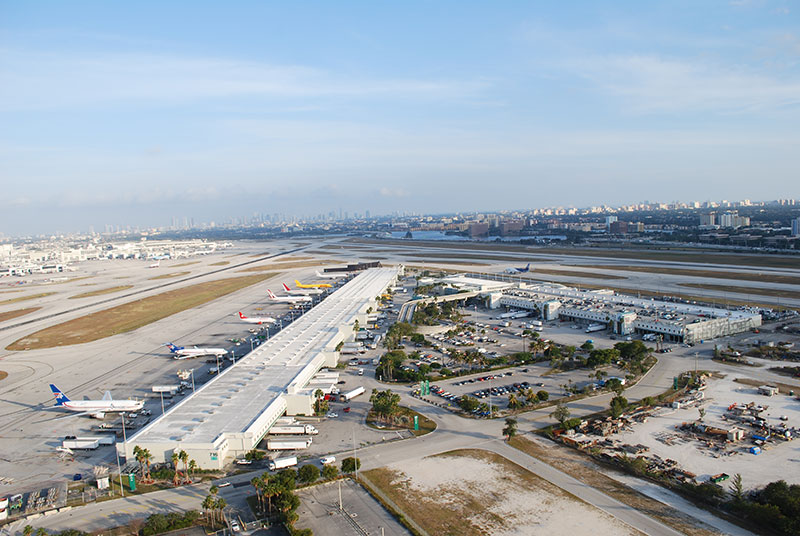Reducing transportation-related fuel consumption will have the largest single impact on communitywide emissions in Miami-Dade County and requires multiple strategies.
These strategies include reducing vehicle and mobile equipment usage, expanding effective low-carbon mobility options, accelerating the electrification of vehicles and equipment, prioritizing those powered by renewable energy, and cutting emissions from our seaport, airports, and other commercial hubs. These are all propositions with multiple long-term economic, health, and climate benefits.Metrics:
- Number of electric vehicles in community and in government fleet
- Public Transportation ridership
Transit Oriented Development (TODs) can reduce emissions by 20% – 40% by reducing the need for residents to drive to access goods, services, schools, and jobs. In addition to Miami-Dade County’s own TODs, the County’s Board of County Commissioners approved the creation of a downtown rapid transit zoning district to encourage TOD investments from the private sector. In the downtown area, one resulting project has been the MiamiCentral station of the Brightline commuter rail with service beginning in 2018. Development of two residential towers has also been initiated in addition to retail space. Best of all, Brightline development is adjacent to the County’s Metrorail and Metromover stations, with future connections to the existing Tri-Rail and planned Northeast SMART Corridor commuter rail lines.
Land use development patterns and zoning impact the amount of time necessary to travel to obtain goods and services. For example, when development is spread widely across a geographic area, people need to travel farther to get to work or run errands. As of 2018, among large metro areas, Greater Miami had the 12th-worst traffic congestion and the 13th-longest commute time in the United States. Traffic, operational conditions, or business protocols can all lead to idling of vehicles, vessels, aircraft and other equipment, resulting in air pollution, wasted fuel, excess heat and excess engine wear. Reduced idling can therefore have many benefits, such as preventing riders from being exposed to diesel exhaust, reducing emissions, and saving money due to reduced fuel purchases.
Actions to reduce vehicle and mobile equipment usage:
- Design an Alternative Workplace Solutions policy and program for Miami-Dade County to maintain and expand the number of employees who telecommute and explore methods to encourage other large employers to implement telecommuting [Community Recommendation]
- Double the utilization of roundabouts instead of traditional street intersections
- Facilitate infill, compact, and mixed-use redevelopment with increased density [Community Recommendation], especially along SMART Plan Corridors
- Build transit-oriented developments [Community Recommendation]
- Make sure bus stops are positioned under trees or other means of shade to safeguard transit users from extreme heat [Community Recommendation]
- Pilot a Mobility-as-a-Service (MaaS) program
- Implement a Countywide Mobility Rewards Program to incentivize the use of public transportation and integration among mobility providers [Community Recommendation]
- Partner with Miami-Dade County Schools to analyze and propose adjustments to school schedules to minimize traffic when school is in session
- Expand effective low-carbon mobility options

In June of 2021, Miami-Dade County’s Department of Transportation and Public Works (DTPW) broke ground for the all-new South Corridor Bus Rapid Transit (BRT) Project. Once completed, this BRT project will provide 20 miles of exclusive transit right-of-way, parallel to US-1, with signal preemption, offering an easy 60-minute ride on all-electric buses from Homestead to Downtown Miami.
Nearly half of Miami-Dade households have limited or no access to a private car. The Covid-19 crisis added new uncertainty to residents' transportation options, especially for public transportation. Expanding the mix of reliable, safe, and convenient low-carbon transportation options, including public transit, bicycling, walking, and micro-mobility (e.g. electric scooters) can increase the shift away from driving and is critical to ensure the economic and social well-being of all Miami-Dade residents. These options reduce the number of vehicles on crowded roads and cut air pollution, directly improving health in communities.
Actions to expand effective low-carbon mobility options:
- Implement the Miami-Dade 2045 Bicycle/Pedestrian Master Plan
- Develop and implement a pedestrian prioritization plan
- Implement Complete Streets and Vision Zero pedestrian and cyclist safety programs
- Rapidly deploy premium public transit solutions along SMART plan corridors to increase ridership and mode shift from single occupancy vehicles
- Allow the use of excess solar power at Countywide bus shelters to power micromobility/electric bicycle equipment. [Community Recommendation]
- Explore the use of all County-owned property for deployment of DTPW first- and last-mile services, such as electric bicycle stations, protected bicycle parking, universal bicycle racks, on-demand and ridesharing pick-up/drop-off
In September of 2021, the County officially opened its first downtown public access chargers through an innovative marketing partnership agreement with a local business. This brings the County’s total to 59 electric vehicle charging ports, the majority of which can be used by the public.

Miami-Dade County will soon have one of the largest sustainable bus fleets in Florida, and one of the largest in the nation. The County’s Board of County Commissioners has approved procurement of 75 battery-powered 40-foot electric buses, with chargers to be installed across three bus depots. Electric buses have zero tailpipe emissions, saving approximately 230,000 pounds of greenhouse gases annually per bus compared to a traditional diesel bus.
Economic forces increasingly point to a future in which electric vehicles (EVs) are the standard. Every year, prices for EVs drop, the variety of models expands, and the number of charging stations increases. Right now, electric cars are cheaper to fuel (charge) and maintain than traditional vehicles that use fossil fuels. Policies and programs that accelerate EV adoption in Miami-Dade County will create new industries and prepare us for a true low-carbon future once vehicles are charged by renewable energy sources. Methodologies for fostering vehicle electrification differ based on the two main types of vehicle owners/users: either the general public or large fleet owners, typically businesses or governments.
Actions to Electrify the County Fleet and Equipment:
- Complete a light fleet electrification analysis to guide replacement of County-owned fossil-fuel vehicles with battery-electric vehicles (BEVs)
- Modify procurement methodologies to account for lifecycle operational and maintenance cost savings of electric vehicles and equipment options
- Complete assessments of key County facilities to determine where to install EV charging infrastructure
- Find funding and modify facilities to install charging infrastructure, prioritizing charging infrastructure that is EnergyStar certified and, wherever possible, use renewable energy
- Complete assessments of County equipment to determine which equipment types should be prioritized for electrification
- Construct new or retrofit existing County bus shelters so they are powered by solar, unless there are impracticalities such as shading
- Deploy electric buses to serve disadvantaged communities as the first priority to help redress historic inequity issues
Actions to Accelerate Community Vehicle and Equipment Electrification:
- Enforce and expand ordinances and other measures that require public charging infrastructure
- Assist existing multi-family residential, office and commercial properties to retrofit for EV charging
- Facilitate community education on the economic, social, and environmental benefits of vehicle and equipment electrification. [Community Recommendation]
- Establish local regulations or other policy measures to ensure that all autonomous vehicles operating in Miami-Dade County are electric
- Encourage the use of low or no emissions landscaping and gardening equipment
- Use LED street lights as EV charging stations for on-street parking
PortMiami Shore Power
Miami-Dade County, in collaboration with the cruise line industry and local utility Florida Power and Light, is slated to have shore power capability in place at five cruise terminals by 2023, and will likely be the first port in Florida and the southeastern U.S. to provide shore power hookups. Shore power will allow cruise ships at PortMiami to turn off their engines while docked, demonstrating an investment in sustainable transportation infrastructure that will reduce carbon emissions. The United States Environmental Protection Agency awarded a two million dollar grant to the County in support of the project’s first phase.

Airport Visual Docking Guidance System
Miami-International Airport is expanding its automated docking system to additional terminals. The automated system provides real-time information to pilots for aircraft gate parking and push back upon departure. The automation facilitates faster aircraft turn-around, thereby reducing delays for airlines and their passengers. The system can also help aircraft and support vehicles reduce engine run-times, thereby reducing carbon emissions from the airfield.
PortMiami and Miami-Dade airports, anchored by Miami International Airport (MIA), have helped make South Florida an international gateway to the world, where successful movement of freight and passengers allows tourism and commerce to thrive. Our local ports also create hundreds of thousands of jobs. At the same time, our planes, port trucks, trains, cargo-handling equipment, and ships use a lot of fuel. In fact, emissions from jet-fuel consumption at Miami International Airport represent nearly a quarter of all emissions in Miami-Dade County. Diesel engines are also common at our ports and emit significant amounts of air pollution, especially older engine models, which impact human and earth-system health and therefore intensify climate change and economic disruption.

U.S. ports and the large commercial companies they serve have started to pursue aggressive strategies to reduce greenhouse gas emissions. By rapidly addressing the challenges of climate change, Miami-Dade County ports can demonstrate leadership in the emerging low-carbon economy while serving as an incubator for best practices that will ensure continued economic health and competitiveness.
Actions to Reduce Emissions at PortMiami, Airports & Other Commercial Hubs:
- Set cumulative goals to reduce emissions within PortMiami and MIA facilities, and develop plans with cruise lines and airlines to reduce emissions using best practices from the EPA National Port Strategy Assessment and ACI’s Airport Carbon Accreditation program
- Educate and work with airport and seaport facility user groups/tenants on industry-best practices for reducing fuel consumption
- Install Visual Guidance Docking System (VDGS) at airports to reduce aircraft idling
- Implement a shore power program for PortMiami cruise operations
- Support fuel reductions through other changes to fueling infrastructure, facilities, and operations such as: replacing older inefficient equipment and fleets, including vessels and aircraft; making operational improvements to reduce idling; switching to renewable, electric, or hydrogen fuels; improving routing and delivery efficiencies; prioritizing facility construction and modifications that increase water and energy efficiency and solar; and promoting related behavioral and educational efforts
Goals & Objectives
Shift 10% of transportation mode away from single occupant vehicles by 2030
Electrify the County fleet: 80% of light vehicles and 50% of buses by 2030
Work to transition 30% of communitywide vehicles to electric power by 2030
Reduce greenhouse gas emissions from Miami International Airport and PortMiami operations by 50% and 25%, respectively by 2030
Increase productivity
Grow the economy
Create jobs
Save money
Reduce traffic
Reduce accidents
Enhance air quality
Reduce urban heat island
Improve health
Reduce noise
Establish emergency backup power
Prioritize walkability and safety as a communitywide first priority [Community Recommendation].
Complete 50 miles of protected bike lanes in downtown Miami [Community Recommendation].
Work to ensure geographically dispersed and equitable public access to EV chargers that are EnergyStar certified and, whenever possible, use renewable energy.
Establish County policies to prioritize and double the installation of roundabouts instead of traditional street intersections by 2030.
Build out SMART Plan corridors
Implement the community-driven Better Bus Network
Almost 50% of Miami-Dade County’s approximate 900,000 households have zero or limited access to a car; 10% of households have no car and 38% have only one car.
For the average household without a car, the number of jobs accessible by transit within 60 minutes would increase by 29% through implementation of the Better Bus Network.
As of 2018, the average commuter in Miami-Dade loses more than 100 hours of productive time to congestion each year, and this costs roughly $4 billion in lost economic output.
Most electric vehicles (EV) are charged at home 80% of the time.
Electric vehicles save the average Florida owner $763 to $1,259 every year, compared to a gas vehicle.
Contact Us

Environmental Resources Management
Loren Parra
Overtown Transit Village North
701 NW 1st Court,
Miami, FL 33136
305-372-6789
